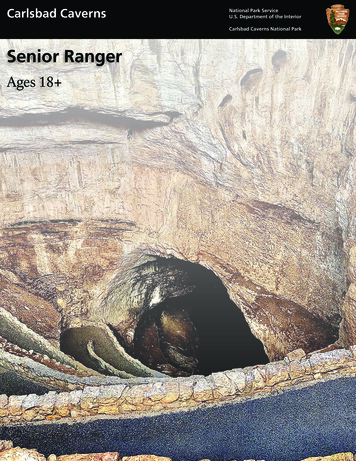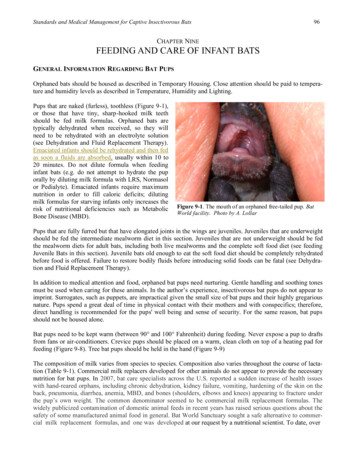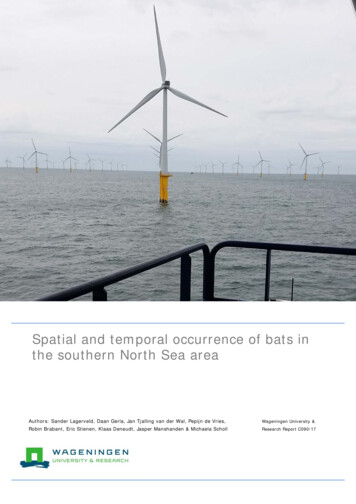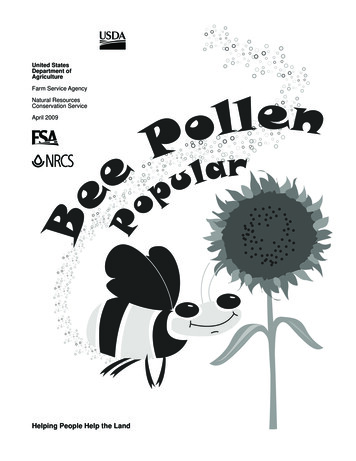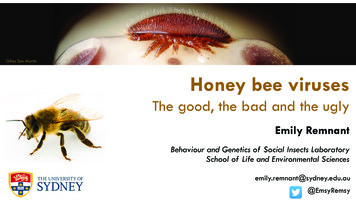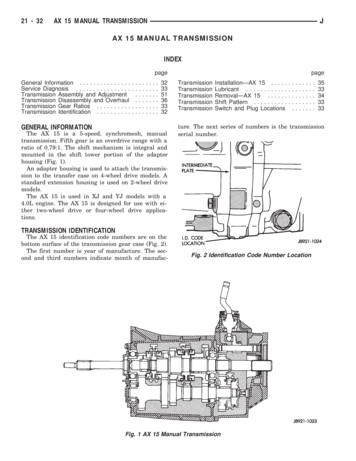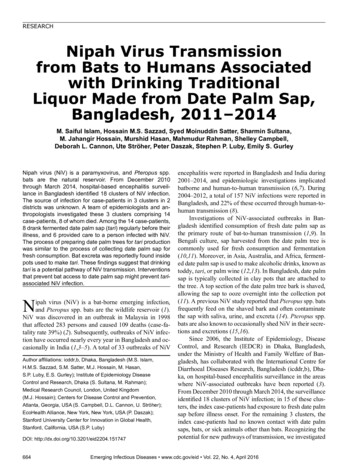
Transcription
RESEARCHNipah Virus Transmissionfrom Bats to Humans Associatedwith Drinking TraditionalLiquor Made from Date Palm Sap,Bangladesh, 2011–2014M. Saiful Islam, Hossain M.S. Sazzad, Syed Moinuddin Satter, Sharmin Sultana,M. Jahangir Hossain, Murshid Hasan, Mahmudur Rahman, Shelley Campbell,Deborah L. Cannon, Ute Ströher, Peter Daszak, Stephen P. Luby, Emily S. GurleyNipah virus (NiV) is a paramyxovirus, and Pteropus spp.bats are the natural reservoir. From December 2010through March 2014, hospital-based encephalitis surveillance in Bangladesh identified 18 clusters of NiV infection.The source of infection for case-patients in 3 clusters in 2districts was unknown. A team of epidemiologists and anthropologists investigated these 3 clusters comprising 14case-patients, 8 of whom died. Among the 14 case-patients,8 drank fermented date palm sap (tari) regularly before theirillness, and 6 provided care to a person infected with NiV.The process of preparing date palm trees for tari productionwas similar to the process of collecting date palm sap forfresh consumption. Bat excreta was reportedly found insidepots used to make tari. These findings suggest that drinkingtari is a potential pathway of NiV transmission. Interventionsthat prevent bat access to date palm sap might prevent tariassociated NiV infection.Nipah virus (NiV) is a bat-borne emerging infection,and Pteropus spp. bats are the wildlife reservoir (1).NiV was discovered in an outbreak in Malaysia in 1998that affected 283 persons and caused 109 deaths (case-fatality rate 39%) (2). Subsequently, outbreaks of NiV infection have occurred nearly every year in Bangladesh and occasionally in India (1,3–5). A total of 33 outbreaks of NiVAuthor affiliations: icddr,b, Dhaka, Bangladesh (M.S. Islam,H.M.S. Sazzad, S.M. Satter, M.J. Hossain, M. Hasan,S.P. Luby, E.S. Gurley); Institute of Epidemiology DiseaseControl and Research, Dhaka (S. Sultana, M. Rahman);Medical Research Council, London, United Kingdom(M.J. Hossain); Centers for Disease Control and Prevention,Atlanta, Georgia, USA (S. Campbell, D.L. Cannon, U. Ströher);EcoHealth Alliance, New York, New York, USA (P. Daszak);Stanford University Center for Innovation in Global Health,Stanford, California, USA (S.P. Luby)DOI: litis were reported in Bangladesh and India during2001–2014, and epidemiologic investigations implicatedbatborne and human-to-human transmission (6,7). During2004–2012, a total of 157 NiV infections were reported inBangladesh, and 22% of these occurred through human-tohuman transmission (8).Investigations of NiV-associated outbreaks in Bangladesh identified consumption of fresh date palm sap asthe primary route of bat-to-human transmission (1,9). InBengali culture, sap harvested from the date palm tree iscommonly used for fresh consumption and fermentation(10,11). Moreover, in Asia, Australia, and Africa, fermented date palm sap is used to make alcoholic drinks, known astoddy, tari, or palm wine (12,13). In Bangladesh, date palmsap is typically collected in clay pots that are attached tothe tree. A top section of the date palm tree bark is shaved,allowing the sap to ooze overnight into the collection pot(11). A previous NiV study reported that Pteropus spp. batsfrequently feed on the shaved bark and often contaminatethe sap with saliva, urine, and excreta (14). Pteropus spp.bats are also known to occasionally shed NiV in their secretions and excretions (15,16).Since 2006, the Institute of Epidemiology, DiseaseControl, and Research (IEDCR) in Dhaka, Bangladesh,under the Ministry of Health and Family Welfare of Bangladesh, has collaborated with the International Centre forDiarrhoeal Diseases Research, Bangladesh (icddr,b), Dhaka, on hospital-based encephalitis surveillance in the areaswhere NiV-associated outbreaks have been reported (3).From December 2010 through March 2014, the surveillanceidentified 18 clusters of NiV infection; in 15 of these clusters, the index case-patients had exposure to fresh date palmsap before illness onset. For the remaining 3 clusters, theindex case-patients had no known contact with date palmsaps, bats, or sick animals other than bats. Recognizing thepotential for new pathways of transmission, we investigatedEmerging Infectious Diseases www.cdc.gov/eid Vol. 22, No. 4, April 2016
Nipah Virus Transmission, Bangladeshother possible exposures to NiV by applying epidemiologicand anthropological approaches in our study of these 3 NiVdisease clusters. We used the epidemiologic study to explainthe proximate individual-level factors linked to the diseaseoutbreak (17) and an anthropological approach to explicatelocal perceptions, behaviors, and practices that might havecontributed to the disease occurrence (18). Therefore, theobjectives of our investigation were to describe the clinicalsigns and symptoms of the case-patients and determine thepossible route of transmission for these clusters.MethodsThe team conducted this study during 2011–2014 in Rajshahi and Rangpur Districts, Bangladesh. Surveillancephysicians from Rangpur Medical College Hospital andRajshahi Medical College Hospital identified suspectedcase-patients (Table), recorded clinical histories and homeaddresses, and collected whole blood samples from each.The serum was separated from each sample, stored in liquid nitrogen at the hospital, and then transported to IEDCR(3). The laboratory team at IEDCR tested serum samplesfor NiV IgM and IgG by using IgM-capture and indirectIgG enzyme immunoassays (19,21).On the basis of type of exposure, we categorized suspected case-patients as primary or secondary case-patients,and these two groups were further categorized as case-patients with probable or laboratory-confirmed NiV infection(Table). To identify a potential NiV infection cluster, surveillance physicians asked each of the admitted suspectedTable. Case definitions for Nipah virus (NiV) infections thatoccurred in 3 clusters, Rangpur and Rajshahi Districts,Bangladesh, 2011, 2012, and 2014Type of caseCase definitionSuspectedFever or history of fever with axillarytemperature 38.5 C, altered mentalstatus, new onset of seizures, or a newneurologic deficit in a patient from anadult or pediatric ward of an NiVsurveillance hospital during the NiVseason (3).ProbableIllness meeting the case definition forsuspected NiV infection in a person wholived in the same village as a person withlaboratory-confirmed NiV infection butwho died before specimens could becollected for diagnosis (19).Laboratory-confirmed Acute onset of fever and subsequentaltered mental status or other neurologicdeficits during the outbreak period andhaving NiV IgM or IgG antibodies inserum (19).PrimaryA case in which illness occurred in theabsence of contact with a symptomaticcase-patient.SecondaryIllness in a person whose only knownexposure was to a case-patient andwhose illness occurred within 5–15 dafter that contact (20).case-patients and their caregivers present in the hospitalabout other sick persons or persons in their communitieswho had recently died with similar symptoms. We defineda NiV infection cluster as 2 suspected meningoencephalitis case-patients living within 30 minutes’ walking distancefrom each other who had onset of similar illnesses within 3weeks of one another or had epidemiologic linkages to oneanother (22).After identifying laboratory-confirmed NiV infectioncases (Table), the team reviewed hospital records, tookpreliminary information from the surveillance physicians,and visited case-patients from each cluster within a monthof case confirmation. We limited this study to clusters inwhich no case-patients had a history of drinking fresh datepalm sap. In the community, the team used a structuredquestionnaire to interview surviving case-patients and thefriends, relatives, and neighbors of deceased case-patientsas proxy respondents. The team collected information related to exposure and signs and symptoms of illness to determine routes of NiV transmission for each case-patient.The team visited the households of case-patients andused culturally appropriate approaches to build rapportand trust with the community (23). The team conductedin-depth interviews and group discussions with surviving case-patients and the family caregivers, friends, andneighbors of the deceased to explore the exposure histories of each case-patient by using an open-ended interviewguide. Open-ended questions allowed the interviewers toobtain new insights about the outbreak. Good rapport withcommunity members helped the team collect informationon potentially sensitive issues, such as alcohol consumption (24), which is prohibited among the majority Muslimpopulation of Bangladesh. The preliminary data collectedduring this study suggested that the case-patients mighthave consumed tari before their illness onset. Therefore,the team also interviewed 5 date palm sap harvesters andconducted 3 group discussions with community membersto learn about tari production, consumption, and sellingpractices in the affected communities. The team also collected and analyzed whole blood samples from survivingcase-patients and from nonpatients (defined as persons inthe community who drank tari with the case-patients butdid not experience any symptoms) by using the same methods described above.Data AnalysisWe used descriptive statistics to characterize the demographic and clinical characteristics of the case-patients. Theteam expanded the observation and interview field notesand summarized them. The primary author (M.S.I.) readsummaries of the interviews and identified themes. Thesethemes were shared among investigators for review andconsensus. The primary author then categorized the dataEmerging Infectious Diseases www.cdc.gov/eid Vol. 22, No. 4, April 2016665
RESEARCHaccording to the selected themes, consistent with methodspreviously described (25).Ethical ConsiderationsThe team obtained verbal informed consent from study participants. The surveillance and outbreak investigation studyprotocol was reviewed and approved by the ICDDR,B Ethical Review Committee.ResultsThree clusters were identified, consisting of 14 case-patients (9 with confirmed NiV infection, 5 with probableNiV infection). Eight of the 14 case-patients were primary case-patients (3 with confirmed NiV infection, 5 withprobable NiV infection). All 6 of the secondary case-patients had confirmed NiV infection. Among the 14 casepatients, 7 had illness onset during January–March 2011in Rangpur District (first cluster), 3 had illness onset inFebruary 2012 in Rajshahi District (second cluster), and 4had illness onset during January–February 2014 in Rangpur District (third cluster). Eight drank tari before theirillness onset, whereas 6 only had exposure to other casepatients. None of the primary case-patients had any history of drinking fresh date palm sap or exposure to sickhumans or animals. All of the illnesses began with fever.All 8 of the primary case-patients had altered mental statusfollowed by loss of consciousness and death. The medianduration from illness onset to death was 6 days. All 6 secondary case-patients survived. The median age of all 14case-patients was 32 years. All the primary case-patientswere male, and all the secondary case-patients were female. None of the non–case-patients had NiV IgM or IgGdetected in their serum samples.In the 2011 Rangpur cluster, case-patients A, B, C, andG drank tari regularly in the evenings, and the sap to maketari was collected from a single village (Figure). Case-patients A and G were family friends and lived in the samevillage. Case-patients B and C were also related and livedin the same village. Case-patients D, E, and F were family caregivers of case-patient C and provided close-contactcare during his illness. All 3 family caregivers experiencedillness within 2 weeks of case-patient C’s illness onset.In the 2012 Rajshahi cluster, case-patient H was a tariproducer and harvester of date palm sap. Case-patient I wasa neighbor and cousin of case-patient H, and both dranktari regularly in the evenings. They drank tari togetherfrom the same pot 6 days before their illness onsets. Casepatient J was a family caregiver of patient H and providedclose-contact care during his illness. She experienced fever11 days after case-patient H’s illness onset.In the 2014 Rangpur cluster, the respondents reportedthat case-patients K and L were family friends and haddrunk tari every day in the evenings before their illnessonsets (Figure). Case-patient L became ill after 5 days aftercase-patient K, and case-patient L did not have any contactwith case-patient K while case-patient K was ill. The tarithey drank was collected from the same village where the2011 Rangpur cluster was identified. Case-patients M andN shared the same bed with case-patient L at home; casepatient N was a family caregiver to case-patient L, providing close-contact care for him at home and in the hospital.Case-patient M had onset of fever 12 days later, and casepatient N had onset of fever 14 days after case-patient L’sillness onset.Tari Production, Processing, and Selling Patterns inRangpur and RajshahiThe area of Rangpur where the case-patients lived waswell known for its tari production and was the largest tariproducing area in the district. An estimated 500 date palmtrees grow in the area, which produces and supplies tarithroughout the district. Tari retailers from different subdistricts of Rangpur also come to this area to buy tari at awholesale price. In the affected villages, the tari producersreported that they had been leasing all the date palm treesfor several years. Villagers reported they did not have regular access to fresh date palm sap because almost all the datepalm sap from the village was made into tari.In the NiV-affected area of Rajshahi, the tari is produced in small quantities. An estimated 15 date palm treesFigure. Timeline of illnessonset in persons with primaryand secondary cases of Nipahvirus infection that occurredin 3 clusters, Rangpur andRajshahi Districts, Bangladesh,2011, 2012, and 2014.Asterisks indicate primarycases; cases without anasterisk are secondary cases.666Emerging Infectious Diseases www.cdc.gov/eid Vol. 22, No. 4, April 2016
Nipah Virus Transmission, Bangladeshgrow in the affected community of Rajshahi. The tari producer leases these trees only during winter to produce tari.The tari production process was identical in each ofthe affected communities. The process of preparing thedate palm trees for tari production was similar to the process for collecting date palm sap for fresh consumption(11). To prepare the tree for tapping, the sap harvesters cutthe old leaves close to the top of the trees with a knife toexpose the tender part of the tree. To tap the tree, the harvesters shave a V-shaped cut at the top of the tree and seta bamboo spigot at the end of the cut. After 3–5 days, theV cut is shaved again, and an earthen pot is hung under thespigot to catch the sap that oozes out. For fresh date palmsap, the harvesters need to clean and dry the sap collectionpots after each episode of sap collection. However, tari harvesters from both affected communities reported that theyuse the same earthen pot for sap collection for several dayswithout cleaning it so that yeast can form at the bottom ofthe earthen pot. Yeast aids the fermentation of the freshdate palm sap in the pot.In Rangpur, the date palm sap is harvested for tari yearround. The harvesters reported that date palm sap can becollected from each tree for 3–4 days a week for 4 monthsat a time, and then the tree is left to recover for the next7–8 months. The harvesters stagger the tapping of treesso there is a continuous supply of date palm sap to maketari throughout the year. The harvesters reported that theyharvest more sap during winter than during other seasonsbecause of higher demand for tari from consumers. Moreover, they reported that the sap flows more freely from eachtree during the winter. In the affected communities, the harvesters reported that every day from 8 a.m. until noon, theycollect the sap from the hanging earthen pots and accumulate the collected sap in other earthen pots or containersand leave the hanging pots on the trees. In Rangpur, theharvesters bring tari to their house and immediately sell itto retailers and consumers from morning until late at night.Occasionally, consumers take tari away with them in plastic bottles. In the affected area of Rajshahi, after being removed from the trees, the tari pots are kept in a betel leafgarden, and the harvesters sell tari from there.The tari sellers and harvesters reported that tari consumers are men and included truck and bus drivers, day laborers,rickshaw pullers, and local farmers. They also reported thattari is less expensive than other illegal alcohol available forsale and that making tari is less laborious than collectingfresh date palm sap because harvesters do not need to cleanand dry the earthen pots after each collection. They addedthat making tari is more profitable than selling fresh datepalm sap. During our visit to communities near to the affected areas in Rangpur, the price of fresh date palm sap was 0.20 per liter, and the price of tari was 0.50 per liter. Theprice differential provides an incentive for making tari.We observed bat roosts in the affected community ofRangpur, and date palm sap harvesters reported that theyfrequently observe bats flying near the date palm trees. Theharvesters reported that they often find bat excreta in andon the sap pots. The harvesters reported filtering tari witha net or cloth before selling it to remove the excreta. InRajshahi, the villagers reported that there is no bat roost intheir community. However, they reported seeing bats visiting date palm trees at night. None of the harvesters in Rajshahi reported filtering tari before selling it to consumers.DiscussionThe laboratory, clinical, and qualitative findings in thisstudy suggest that the 14 case-patients in the 3 clusters weinvestigated were infected with NiV. The primary NiV casepatients identified in the clusters drank tari regularly in theevenings before their illness onsets, and none of them had ahistory of fresh date palm sap consumption or any exposureto other NiV case-patients, which were the main transmission pathways for NiV infection identified in previous outbreak investigations in Bangladesh (9,26). Moreover, noneof the case-patients had exposure to sick animals, anotherpossible pathway for NiV transmission reported in studiesconducted in Malaysia and Singapore (27).Tari is a date palm sap product. Because tari fermentation was a continuous process and date palm sap was fermented inside the tari pots while they were hanging in thetrees, some date palm sap added to the tari might technically be fresh sap. However, the primary case-patients probably did not consume fresh date palm sap because tari wascollected from 8 a.m. to noon but the primary case-patientsdrank tari only in the evening, which suggests that all thesap they consumed was at least partially fermented by thetime of consumption. Findings from this investigation suggest that drinking tari is a potential source of NiV infectionin Bangladesh. Investigators in India had similar findingsduring an outbreak reported in 2007 in West Bengal nearthe border with Bangladesh (4). They reported that drinking fermented date palm sap possibly contaminated withbats excreta and secretions was the source of NiV infectionfor the index patient, which further supports our assertionthat NiV infection from drinking tari is plausible (4). Moreover, 2 clusters in this study were traced back to the sametari production village in Rangpur, further strengtheningthe conclusion that tari was the mode of transmission.Previous studies have shown that fruit bats frequentlylick the date palm sap and occasionally urinate inside collection pots (14). In our investigation, the reported evidence of bats visiting date palm trees, the presence of batexcreta inside tari pots, the reported use of the same pot forseveral days without cleaning, and the accumulation of sapfrom multiple pots into 1 pot suggest that sap is probablycontaminated with bat urine or saliva during collection andEmerging Infectious Diseases www.cdc.gov/eid Vol. 22, No. 4, April 2016667
RESEARCHfermentation. NiV can survive up to 4 days in bat urine andat least 1 day in sap contaminated with bat urine when keptat an average temperature of 19 C (28). A study to determine viability of NiV in artificial palm sap contaminatedwith NiV (strain Bangladesh/200401066) found no statistically significant reduction in NiV titers for at least 7 dayswhen kept at a temperature of 22 C (29). Generally, enveloped and thus lipophilic viruses like NiV are susceptible toalcohol. A 60%–70% alcohol solution is recommended forsterilizing contaminated objects (30). A study conducted inIndia showed that tari derived naturally from fermentingdate palm sap contains 5%–8% alcohol and has a pH of4.5–6.0 (12). This 5%–8% alcohol concentration might nothave been high enough or sufficiently distributed throughout the tari to sterilize the NiV, thus allowing persistenceof viable virus and transmission of NiV to tari consumersduring the winter months, when the ambient temperatureranges from 15 C to 28 C (21).In Bangladesh, family caregivers commonly provideclose-contact care to hospitalized patients (31). Infectedpatients often shed the virus through body secretions andexcretions and can contaminate foods and surfaces, including bed rails, bed sheets, and towels (32,33). Close contactis the most likely route through which family caregiversbecame infected (26). Family caregivers identified in thisstudy had direct contact with primary case-patients andtheir body secretions.The findings of our study are subject to limitations.First, some participants may have been reluctant to report production, consumption, and selling of tari becausethese are illegal activities in Bangladesh. Initially, someof the date palm sap harvesters and tari producers werereluctant to share information with us. However, the social scientists on the investigation team built rapport andtrust with the respondents, which encouraged the respondents to share sensitive information (23). Thus, the hesitance to disclose behaviors related to tari probably didnot have a substantial effect on our findings. Second,no control group was available. Without a comparisongroup, we were unable to determine if our primary casepatients were more likely than other persons residing inthese villages to drink tari. However, given the absence ofevidence that the primary case-patients had other contactwith bats, sick animals, or persons with NiV infection,consumption of tari appears to be the most likely transmission route. Third, we interviewed family members andfriends of the deceased case-patients as proxy respondentsto ascertain case exposures. However, during outbreaks offatal diseases such as NiV infection (with a case-fatalityrate 70%), there is no alternative to this approach (20).Since 2003, we have interviewed proxy respondents forcase-exposures in every NiV-associated outbreak investigation conducted in Bangladesh (3,9,19). Fourth, because668of the delays in investigation of the 2011 cluster, our definition for a confirmed cases of NiV infection was basedon the presence of NiV IgM or IgG in serum samples.Confirming a case based on the presence of IgG is reasonable, however, because all the family caregivers from the2011 Rangpur cluster had illness onset within 2 weeksafter contact with a case-patient (19).Because harvesting date palm sap for tari productionis similar to harvesting it for consumption of fresh datepalm sap, the intervention of using bamboo skirts to coverthe shaved part of the date palm tree and the sap collectionpots to prevent bat contact and possible NiV introductionis worth exploring. The use of bamboo skirts is already asuccessful, affordable, and culturally acceptable method toprevent bat access to date palm sap, and this strategy couldalso be used to prevent NiV transmission from tari consumption (34,35). In addition, tari harvesters from ethnicminority communities have limited access to mass mediabecause of their ethnic, religious, and linguistic minoritystatus in Bangladesh. Efforts should be made to raise theirawareness about strategies that interrupt bat access to datepalm sap. At this time, we are not aware of any studies thathave tested the survival of NiV in tari. As a next step, werecommend testing NiV survival in tari at different levelsof alcohol concentration.All 3 of the clusters of NiV infection that we investigated were linked to drinking tari. Drinking tari might alsobe a route of exposure for other batborne viruses. A totalof 55 newly described viruses from 7 virus families wererecently identified in urine and saliva from Pteropus spp.bats in Bangladesh (36), suggesting that these bats couldalso contaminate tari with other viruses that could causedisease in humans. Date palm sap is harvested for fermentation in many areas where Pteropus spp. bats and otherfruit bats are native, including Australia, Asia, and Africa(37–40). Consumers of fermented drinks and other datepalm products that are harvested using similar processes asin Bangladesh might be at risk for NiV infection and otherbatborne diseases (12,13,36).AcknowledgmentsWe thank all the study participants for their time and support.Diana Diaz-Granados deserves special thanks for her contributions in reviewing the manuscript.The study was funded by the US Centers for Disease Control andPrevention (CDC) cooperative agreement no. 5U01CI000628-01,the US National Institutes of Health (NIH) grant no. 07-0150712-52200 (Bangladesh-NIH/Emerging Infectious Disease),and National Science Foundation/NIH Ecology and Evolutionof Infectious Diseases grant no. 2R01-TW005869 from theFogarty International Center. ICDDR,B also acknowledges withgratitude the commitment of CDC, NIH, and the government ofEmerging Infectious Diseases www.cdc.gov/eid Vol. 22, No. 4, April 2016
Nipah Virus Transmission, BangladeshBangladesh to its research efforts. icddr,b is also grateful to thegovernments of Australia, Bangladesh, Canada, Sweden, and theUnited Kingdom for providing core/unrestricted support.Mr. Islam is a social scientist working with the Centre for Communicable Diseases at icddr,b. His research interests includezoonotic diseases, emerging and reemerging infectious diseases,cultural epidemiology, infection control, and prevention in hospital and community 4.15.Luby SP. The pandemic potential of Nipah virus. Antiviral Res.2013;100:38–43. hua KB. Nipah virus outbreak in Malaysia. J Clin Virol. 2003;26:265–75. zad HM, Hossain MJ, Gurley ES, Ameen KM, Parveen S,Islam MS, et al. Nipah virus infection outbreak with nosocomialand corpse-to-human transmission, Bangladesh. Emerg Infect Dis.2013;19:210–7. http://dx.doi.org/10.3201/eid1902.120971Arankalle VA, Bandyopadhyay BT, Ramdasi AY, Jadi R, Patil DR,Rahman M, et al. Genomic characterization of Nipah virus, WestBengal, India. Emerg Infect Dis. 2011;17:907–9. http://dx.doi.org/10.3201/eid1705.100968Chadha MS, Comer JA, Lowe L, Rota PA, Rollin PE, Bellini WJ,et al. Nipah virus–associated encephalitis outbreak, Siliguri, India.Emerg Infect Dis. 2006;12:235–40. http://dx.doi.org/10.3201/eid1202.051247World Health Organization. Nipah virus outbreaks in the WHOSouth-East Asia Region. Surveillance and outbreak alert [cited2015 Feb 25]. http://www.searo.who.int/entity/emerging diseases/links/nipah virus outbreaks searInstitute of Epidemiology, Disease Control, and Research.Nipah outbreak—2014 [cited 2015 Apr 7]. http://www.iedcr.org/index.php?option com content&view article&id 106Hegde ST, Sazzad HM, Hossain MJ, Kenah E, Daszak P,Rahman M, et al. Risk factor analysis for Nipah infection inBangladesh, 2004 to 2012. Presented at: 62nd Annual Meeting ofthe American Journal of Tropical Medicine and Hygiene 2013;2013 Nov 13–17; Washington, DC, USA.Luby SP, Rahman M, Hossain MJ, Blum LS, Husain MM,Gurley E, et al. Foodborne transmission of Nipah virus,Bangladesh. Emerg Infect Dis. 2.060732Annett HE, Lele GK, Amin BM. The date sugar industry in Bengal:an investigation into its chemistry and agriculture. London:W. Thacker & Co; 1913.Nahar N, Sultana R, Gurley ES, Hossain MJ, Luby SP.Date palm sap collection: exploring opportunities to preventNipah transmission. EcoHealth. 2010;7:196–203. sekhar K, Sreevani S, Seshapani P, Pramodhakumari J.A review on palm wine. Int J Res Biol Sci. 2012;2:33–38.Zaid A. Origin, geographical distribution, and nutritionalvalues of date palm. In: Zaid A, editor. Date palm cultivation.Rome: Food and Agricultural Organization of the United Nations;2002.Khan MS, Hossain J, Gurley ES, Nahar N, Sultana R, Luby SP.Use of infrared camera to understand bats’ access to date palm sap:implications for preventing Nipah virus transmission. EcoHealth.2010;7:517–25. http://dx.doi.org/10.1007/s10393-010-0366-2Chua KB, Koh CL, Hooi PS, Wee KF, Khong JH, Chua BH,et al. Isolation of Nipah virus from Malaysian Island flying-foxes.Microbes Infect. 2002;4:145–51. http://dx.doi.org/10.1016/S1286-4579(01)01522-216. Wacharapluesadee S, Lumlertdacha B, Boongird K,Wanghongsa S, Chanhome L, Rollin P, et al. Bat Nipah virus,Thailand. Emerg Infect Dis. 2005;11:1949–51. http://dx.doi.org/10.3201/eid1112.05061317. McMichael AJ. Prisoners of the proximate: loosening theconstraints on epidemiology in an age of change.Am J Epidemiol. 1999;149:887–97. 3218. Islam MS, Luby SP, Gurley ES. De
Bengali culture, sap harvested from the date palm tree is commonly used for fresh consumption and fermentation (10,11). Moreover, in Asia, Australia, and Africa, ferment - ed date palm sap is used to make alcoholic drinks, known as toddy, tari, or palm wine (12,13). In Bangladesh, date palm sap is typically collected in clay pots that are .



